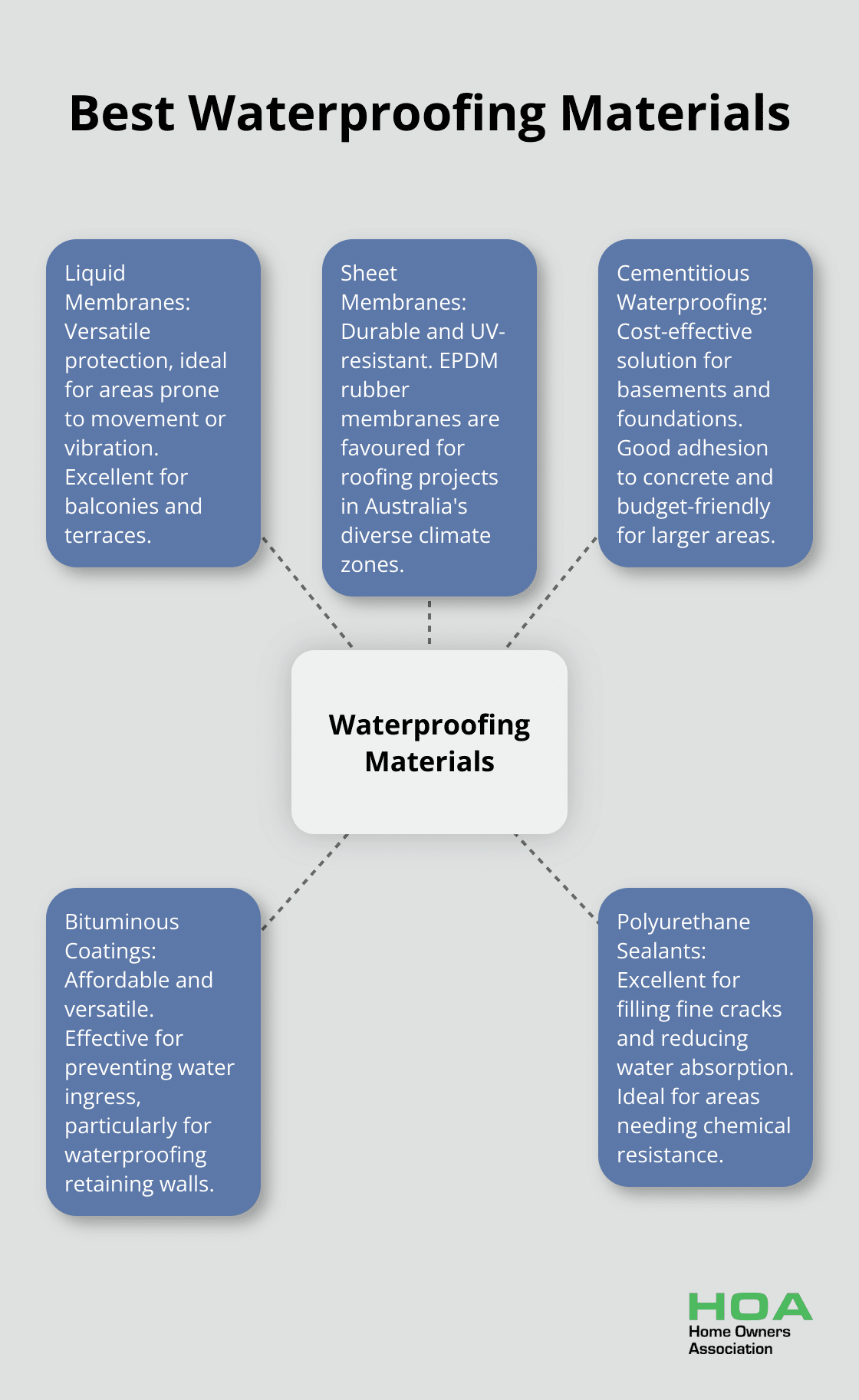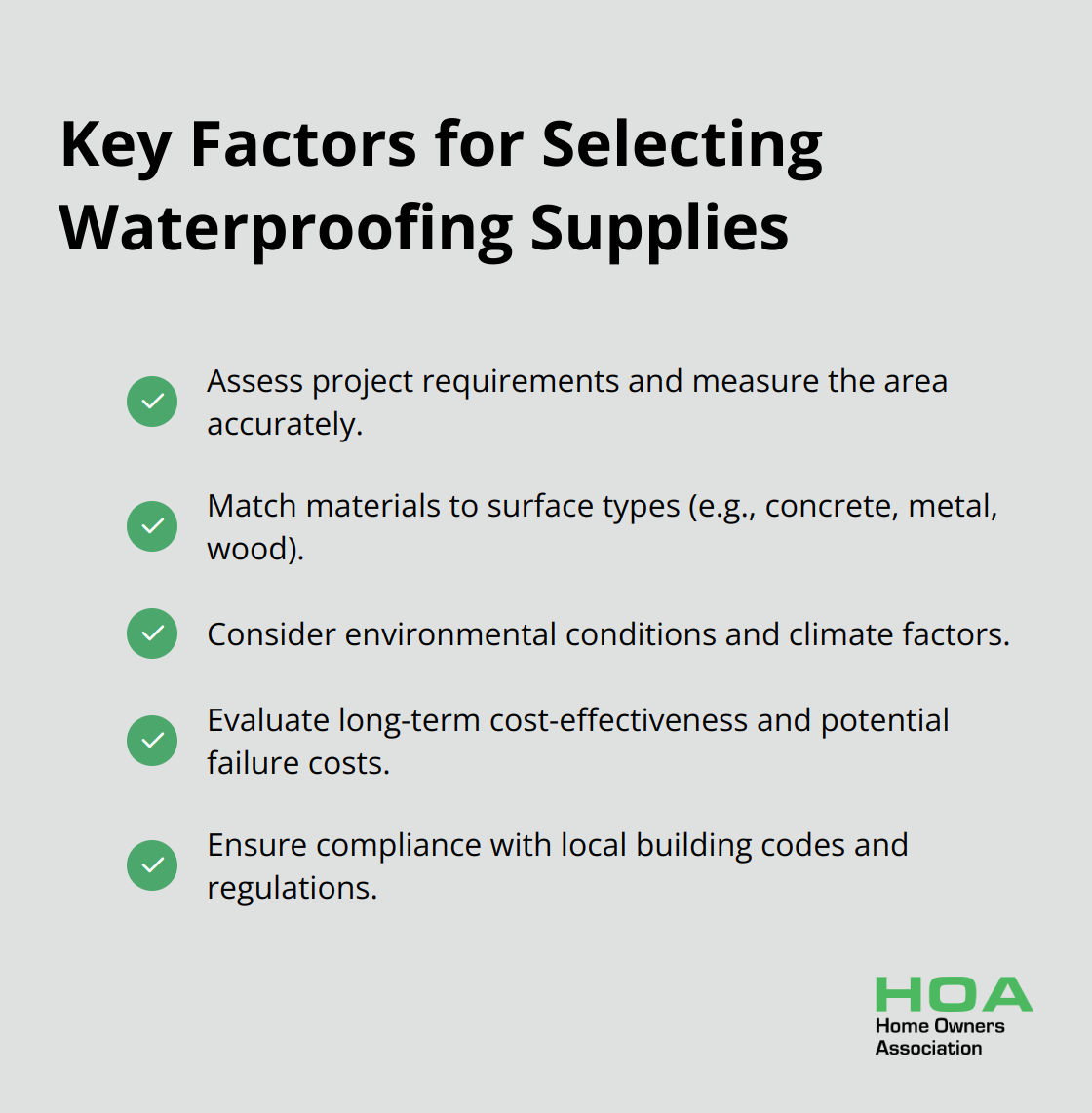
At Home Owners Association, we understand the importance of protecting your property from water damage. Effective waterproofing is essential for maintaining the structural integrity and value of your home.
This guide will walk you through the total waterproofing supplies you need to safeguard your property. From essential materials to tools and equipment, we’ll cover everything you need to know to make informed decisions about your waterproofing project.
What Are the Best Waterproofing Materials?
At Home Owners Association, we have observed numerous waterproofing projects across Australia. Our experience indicates that selecting the right materials is essential for long-lasting protection. Let’s explore the top waterproofing materials that have proven their effectiveness in various Australian climates.

Liquid Membranes: Versatile Protection
Liquid membranes are a popular choice for many of our members. SEMCO Liquid Membrane is a liquid waterproofing membrane that can be used underneath new surfaces or as a waterproofing sealer over an existing surface.
Polyurethane-based liquid membranes offer superior flexibility, making them ideal for areas prone to movement or vibration. They perform particularly well on balconies and terraces, where UV resistance is important.
Sheet Membranes: Durable and UV-Resistant
Sheet membranes are specially designed for total reliability and superior performance for below grade through to exposed roofing applications.
EPDM rubber membranes are favoured among our members for roofing projects. Their flexibility suits a wide range of temperatures, which is necessary in Australia’s diverse climate zones.
Cementitious Waterproofing: Cost-Effective Solution
Cementitious waterproofing coatings work well for basements and foundations. They are easy to apply and effective for both positive and negative side waterproofing. While they may not offer the flexibility of some other options, their good adhesion to concrete makes them reliable for many applications.
These coatings are also budget-friendly, making them attractive for larger areas where cost is a significant factor.
Bituminous Coatings: Affordable and Versatile
Bituminous coatings have been a staple in the waterproofing industry for years. They are affordable and can be used on various building types.
While not the most eco-friendly option, their effectiveness in preventing water ingress is undeniable. They work particularly well for waterproofing retaining walls, where hydrostatic pressure can be a significant concern.
Polyurethane Sealants: Crack-Filling Champions
For areas with fine cracks or where chemical resistance is needed, polyurethane sealants are the top choice. They excel at filling fine cracks and reducing water absorption. Their chemical resistance makes them ideal for industrial applications or areas exposed to harsh conditions.
The best waterproofing material for your project depends on various factors (including the specific application, climate conditions, and budget). We always recommend consulting with a waterproofing expert to ensure you’re making the best choice for your property.
Now that we’ve covered the best waterproofing materials, let’s move on to the tools and equipment you’ll need to apply these materials effectively.
Essential Tools for Waterproofing Success
At Home Owners Association, we know that having the right tools is just as important as choosing the correct materials for waterproofing projects. Let’s explore the essential equipment you’ll need to ensure your waterproofing project succeeds.
Application Tools: The Basics
Trowels and brushes form the foundation of any waterproofing job. Notched trowels help spread liquid membranes evenly, while stiff-bristled brushes apply cementitious coatings effectively. For larger areas, rollers can speed up the application process significantly. When working with polyurethane sealants, a caulking gun provides precise application.
For bigger projects, an airless sprayer can cover large surfaces quickly and evenly, especially when applying liquid membranes. However, sprayers require more skill to use effectively and may cause overspray if not handled properly.
Moisture Detection: A Critical Step
Before you start waterproofing, you must assess the moisture content of the surface. Moisture meters detect hidden moisture that might compromise your waterproofing efforts if left unchecked. There are two main types of moisture meters for building materials: capacitance (or non-destructive) and resistance (pin-style).
A study found that 85 per cent of buildings had been damaged by water at some time, and 45 per cent had leaks at the time of data collection. Using a moisture meter can help you identify problem areas before they escalate, saving you time and money in the long run.

Sealing and Reinforcing
Waterproofing tape reinforces joints, seams, and corners. It’s particularly useful when working with sheet membranes or in areas prone to movement. High-quality waterproofing tape can significantly enhance the longevity of your waterproofing system.
For areas with existing cracks or joints, use a reinforcing fabric in conjunction with your liquid membrane. This combination creates a more robust waterproofing layer that can better withstand structural movement.
Safety First: Essential Gear
Safety should never take a back seat in any waterproofing project. Proper safety gear is non-negotiable. This includes:
- Respirators or masks to protect against fumes and dust
- Safety goggles to shield your eyes from splashes
- Chemical-resistant gloves to protect your skin
- Non-slip shoes for secure footing on wet surfaces
Many waterproofing products contain chemicals that can harm if inhaled or in contact with skin. Always read the manufacturer’s safety instructions and use the recommended protective equipment.
Investing in quality tools and safety gear might seem like an additional expense, but it’s a small price to pay for a job well done and your personal safety. The right tools can make a significant difference in the outcome of a waterproofing project (improving work quality, efficiency, and safety for everyone involved).
Now that we’ve covered the essential tools for waterproofing, let’s move on to choosing the right waterproofing supplies for your specific project needs.
How to Select the Right Waterproofing Supplies
At Home Owners Association, we understand the importance of choosing the correct waterproofing supplies for your project. This guide will help you make informed decisions to protect your property effectively.

Assess Your Project’s Unique Requirements
Start with a thorough evaluation of your project. Different scenarios demand specific solutions. A basement might benefit from cementitious waterproofing, which is easy to apply and provides a protective barrier against water and moisture, while a balcony requires a flexible, UV-resistant option like polyurethane-based liquid membranes.
Measure the area accurately. Add 10% extra for wastage and potential mistakes. This approach prevents unnecessary expenses or material shortages mid-project.
Match Materials to Surface Types
Different surfaces require specific waterproofing materials:
- Concrete works well with cementitious coatings due to their excellent adhesion properties.
- Metal surfaces often need elastomeric coatings for flexibility and corrosion resistance.
- Wood requires flexible membranes that move with the substrate.
Avoid bituminous coatings on surfaces exposed to sunlight, as they tend to degrade under UV radiation.
Factor in Environmental Conditions
Australia’s diverse climate influences your choice of waterproofing supplies:
- Coastal areas: Choose materials with enhanced corrosion resistance.
- Regions with extreme temperature fluctuations: Opt for products with high elasticity.
- Areas with heavy rainfall: Select materials with excellent water resistance and quick-drying properties.
- Drier regions: Prioritise UV resistance.
Consider Long-Term Cost-Effectiveness
Invest in high-quality waterproofing supplies for long-term benefits. Compare the lifespan, maintenance requirements, and potential failure costs of different options.
Non-exposed membrane systems, also known as protected membrane systems, require a maintenance program to ensure longevity during their operational life.
Industry data shows that water damage repairs can cost between $1,000 and $100,000, depending on the extent of the damage. This fact underscores the importance of quality waterproofing.
Ensure Compliance with Building Codes
Check local building codes before purchasing waterproofing supplies. Australian states and territories have varying requirements, especially for wet areas like bathrooms and balconies.
The Building Code of Australia (BCA) specifies minimum waterproofing requirements for different areas of a building. Non-compliance can lead to failed inspections, costly rework, and potential legal issues.
Consult with a licensed waterproofing professional or your local building authority for guidance on suitable products that meet both your needs and local regulations.
Final Thoughts
Selecting the right total waterproofing supplies protects your property from water damage. We explored essential materials like liquid membranes, sheet membranes, and cementitious coatings, each offering unique benefits for different applications. The right tools and safety equipment ensure effective application and personal protection during the waterproofing process.
Quality waterproofing preserves the structural integrity of your property and maintains its value over time. The long-term benefits of proper waterproofing outweigh the initial investment (providing protection against potential water-related issues). Effective waterproofing prevents leaks and safeguards your property for years to come.
We at Home Owners Association help Melbourne homeowners make informed decisions about their waterproofing projects. Our members receive expert advice, access to trade pricing, and resources to ensure successful home improvement outcomes. You can safeguard your property effectively and tackle any waterproofing challenge with confidence.





